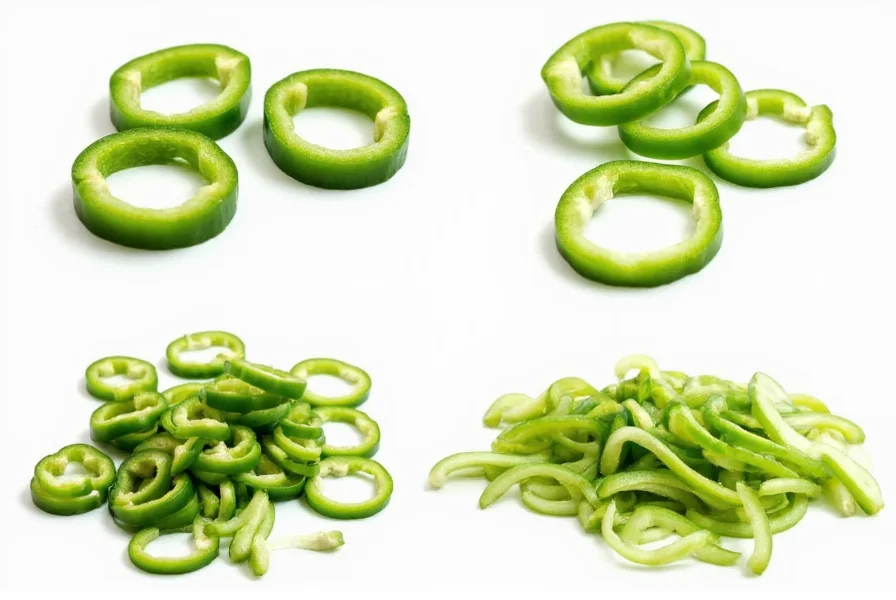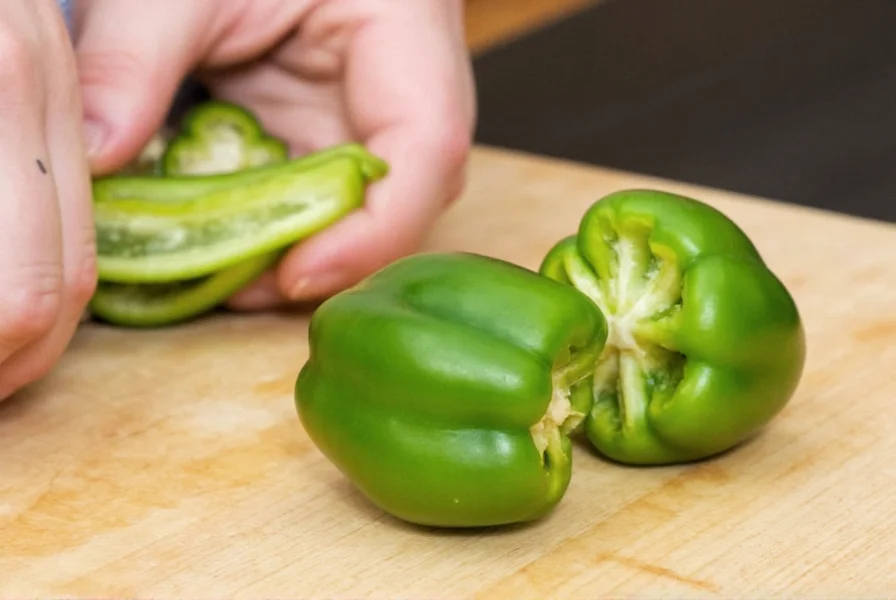Mastering the proper technique for cutting green peppers ensures cleaner cuts, reduces waste, and minimizes the risk of kitchen accidents. Whether you're preparing a stir-fry, salad, or stuffed peppers, understanding how to cut green peppers properly transforms your cooking experience from frustrating to fluid.
Essential Tools for Cutting Green Peppers
Before learning how to slice bell peppers efficiently, gather these kitchen essentials:
- A sharp chef's knife (8-10 inches)
- A stable cutting board (wood or plastic)
- A small bowl for seeds and core
- Damp kitchen towel (for board stability)
Using a properly sharpened knife is crucial for safely dice green peppers without slipping. A dull blade requires more pressure, increasing injury risk. Always keep your fingers curled away from the blade path using the "claw grip" technique.
Step-by-Step Guide to Cutting Green Peppers
1. Preparation and Safety
Wash the pepper thoroughly under cold water and dry with a clean towel. Place your cutting board on a damp cloth to prevent slipping. Position yourself with good lighting and ample workspace. This foundational step in how to prepare green peppers for cooking prevents accidents before you begin cutting.
| Pepper Cutting Method | Best For | Time Required |
|---|---|---|
| Slicing into rings | Burgers, sandwiches | 2-3 minutes |
| Dicing (small cubes) | Sauces, salsas, stir-fries | 3-4 minutes |
| Julienne (matchsticks) | Stir-fries, fajitas | 3-5 minutes |
| Quartering | Stuffed peppers, roasting | 2 minutes |
2. Removing the Top and Bottom
Place the pepper vertically on your cutting board. Using a sharp knife, slice approximately ¼ inch below the stem to remove the top. Rotate the pepper and repeat at the bottom. This creates stable, flat surfaces—essential for efficient pepper cutting method that prevents rolling.

3. Removing the Core and Seeds
Stand the pepper upright on one of the flat ends. Insert your knife just beside one of the natural ridges (the white ribs inside) and cut downward toward the bottom, following the pepper's natural shape. Repeat this around the entire pepper to separate the flesh from the core. Gently remove the core with seeds intact. This technique for remove seeds from green pepper minimizes waste and keeps cuts clean.
4. Cutting Techniques for Different Recipes
Slicing into Rings
Lay the pepper halves flat side down. Cut crosswise into uniform rings of your desired thickness. Ideal for sandwiches and burgers.
Dicing (Small Cubes)
After removing the core, lay pepper halves flat. Make lengthwise cuts, then rotate and cut crosswise to create uniform cubes. Perfect for salsas and cooked dishes where even cooking matters.
Julienne (Matchstick Cuts)
Cut the pepper halves lengthwise into thin strips, then stack and cut again lengthwise for matchstick pieces. Excellent for stir-fries and fajitas.

Pro Tips for Cutting Peppers Without Tears
Unlike onions, green peppers don't typically make you cry, but these tips enhance your experience:
- Cut near an open window or under a vent to disperse any volatile compounds
- Chill peppers in the refrigerator for 30 minutes before cutting for firmer texture
- Use a sharp knife to minimize cell damage and potential irritation
- Consider wearing food-safe gloves if you have sensitive skin
Storing Cut Green Peppers
Proper storage extends freshness after you've completed how to cut peppers for meal prep:
- Place cut peppers in an airtight container with a slightly damp paper towel
- Store in the crisper drawer of your refrigerator
- Consume within 3-4 days for best quality
- For longer storage, freeze diced peppers on a baking sheet before transferring to freezer bags
Common Mistakes to Avoid
Even experienced cooks make these errors when learning proper way to cut green peppers:
- Using a dull knife - Increases slipping risk and creates uneven cuts
- Cutting while the pepper rolls - Always create flat surfaces first
- Removing too much flesh with the core - Follow the natural ridges
- Washing after cutting - Wash before to prevent waterlogged texture
- Storing in non-airtight containers - Causes premature wilting
Why Technique Matters for Green Peppers
The right approach to green pepper cutting techniques affects both safety and culinary results. Properly cut peppers cook evenly, maintain better texture, and present more attractively in dishes. When you master how to cut green peppers safely, you'll notice reduced kitchen stress and improved cooking efficiency. The time invested in learning these techniques pays dividends in every meal you prepare with bell peppers.
What's the easiest way to remove seeds from green peppers?
The easiest method is standing the pepper upright after trimming top and bottom, then cutting along the natural white ribs to separate the flesh from the core in one motion. This removes the entire seed cluster intact without damaging the pepper flesh.
Can I cut green peppers without a chef's knife?
While a chef's knife is ideal for how to cut green peppers properly, you can use a serrated knife for the initial top and bottom cuts if your chef's knife isn't sharp. However, avoid using small paring knives for the main cutting as they provide less control and increase injury risk.
Why do my green peppers become soggy after cutting?
Peppers become soggy when stored with excess moisture. Always dry peppers thoroughly before cutting and store cut pieces with a slightly damp (not wet) paper towel in an airtight container. Never wash peppers after cutting, as this introduces unnecessary moisture that accelerates spoilage.
How thin should I slice green peppers for stir-fry?
For stir-fries, slice green peppers into ¼-inch thick strips or small dice. This thickness ensures they cook evenly with other vegetables without becoming mushy. When learning how to cut peppers for stir-fry, uniformity matters more than exact thickness—consistent pieces cook at the same rate.
Can I freeze cut green peppers?
Yes, you can freeze cut green peppers. Spread them in a single layer on a baking sheet to freeze individually, then transfer to freezer bags. Frozen peppers work well in cooked dishes but will be softer when thawed, making them unsuitable for raw applications like salads. This is particularly useful for meal prep after how to cut green peppers for freezing.











 浙公网安备
33010002000092号
浙公网安备
33010002000092号 浙B2-20120091-4
浙B2-20120091-4